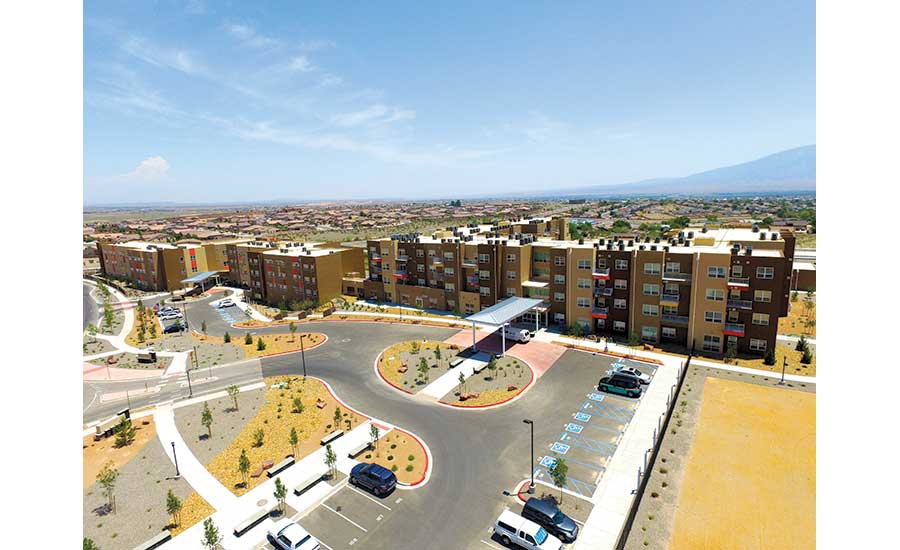Regional Revenue Grows As Contractors Enjoy Rebound
Annual contractors survey reveals a robust market with a corresponding tightness in the availability of trained workers.

Age Focus The Neighborhood in Rio Rancho is one of many senior living complexes in the Southwest. Image Courtesy of Bradbury Stamm Construction
Construction in the Southwest is on the rebound. With a major transportation project in New Mexico’s largest city and numerous major resort projects popping up in Las Vegas, results from this year’s ENR Southwest Top Contractors survey point to a strengthening market.
|
Click Here to View the ENR 2016 Southwest Top Contractors |
According to the survey, the top 10 firms produced combined revenue of $3.10 billion from work performed in the Southwest in 2015. That’s a $30-million increase from the prior year. Revenue from all of the firms participating in the survey rose to $6.46 billion in 2015, compared with $6.07 billion in 2014, an increase of $390 million, even though four fewer firms participated in the survey.
As a result of the gains, builders have been challenged by the shrinking number of trained workers. While other regions have experienced labor shortfalls earlier in the recovery, it is just starting to hit the Southwest in earnest. Nationwide, the number of workers employed in construction-related occupations declined by nearly 985,000, or 15.8%, between 2005 and 2015, according to the most recent occupational employment statistics survey from the Bureau of Labor Statistics.
Andrea Cross, Americas head of office research at CBRE, said this is especially true in metropolitan Phoenix, where construction fell by more than 52,000 workers, or 40.3%, between 2005 and 2015.
At the same time, with development returning to the area, construction labor demand has caused the average hourly wage in Phoenix to increase by 31.7% over that same time period—second highest among the markets examined in a CBRE report.
There is a lack of depth in the labor pool for quality subcontractors in trade areas like millwork and electrical, says Susan LaGanke, senior managing director of CBRE’s project management, Southwest region and multimarkets.
Cynthia Schultz, CEO of Bradbury Stamm—an Albuquerque-based firm that also has offices in Carlsbad and Clovis, N.M., and El Paso, Texas—says her firm feels very good about the construction industry in New Mexico, even if the state’s oil and gas revenue is down.
“Contractors in the region have pretty high backlogs,” she says, adding that medical and senior living facilities are on the rise in the state. For example, a $40-million senior living/continuing care facility was recently completed in Rio Rancho, a thriving suburb of Albuquerque.
Bradbury Stamm is currently working on six senior living projects: three in Colorado; one in El Paso, Texas; and two in Santa Fe.
“A lot is going on in that sector, and that is on par with the rest of the country,” Schultz says.
New Mexico has also experienced a rise in education-related buildings with projects such as a geology building on the New Mexico Institute of Mining & Technology campus in Socorro, south of Albuquerque, and several elementary schools in Carlsbad, N.M.
In Las Vegas this year, the 2008 recession seems a distant memory, as numerous projects have broken ground, including large-scale casinos and smaller commercial endeavors.
John Cannito, chief operating officer of PENTA Building Group, says there is a lot of optimism in the Las Vegas and Nevada markets right now. “Dirt is moving, and projects that have been planned for a while are becoming a reality,” Cannito says. “From our perspective and focus in the region, we are seeing a lot of activity in the tourism and guest experience markets.”
Cannito says there seems to be a good balance between ground-up projects and renovation of existing facilities. “We’ve got a good mix of diverse projects currently under construction,” he adds.
Other PENTA projects include the almost-finished Lucky Dragon Casino and Hotel, billed as “the city’s first resort delivering an authentic Asian cultural and gaming experience,” as well as a clubhouse for the high-end Ascaya housing development and a retail addition along the Las Vegas Strip.


